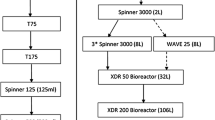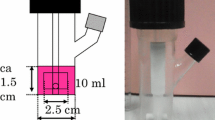Abstract
Chinese hamster ovary cells (CHO-K1) were cultivated in macroporous gelatin microcarriers (CultiSpher G and CultiSpher S) in spinner flasks and a 5 1 bioreactor. Near-to-confluent cultures were harvested by bead-to-bead transfer where intact microcarriers with cells were transferred from a spinner flask to another spinner flask or to the bioreactor with naked microcarrier beads. Successful bead-to-bead transfer was achieved in various split ratios. The duration of attachment seemed to be important where the direct contact of beads to each other can be achieved by intermittent stirring. Repeated transfers were performed and at least four transfers in spinner flasks were achieved.
Two variations of bead-to-bead transfer were performed in the 5 1 bioreactor either by seeding the bioreactor with near-to-confluent beads cultivated in spinner flasks orin situ transfer by adding fresh beads to the bioreactor. As in the spinner case, attachment was achieved by intermittent stirring where donor beads were in close proximity to the acceptor beads. Again successful transfers were obtained as evidenced by the good growth on acceptor beads where cell yields were in the range of 3100–4500 cells/bead.
The results suggest that bead-to-bead transfer of CHO-K1 cells can be easily performed and do provide an alternative route to applications where dissolution techniques may not offer an efficient solution.
Similar content being viewed by others
References
Crespi CL and Thilly WG (1981) Continuous cell propagation using low-charge microcarriers. Biotechnol. Bioeng. 23: 983–993.
Gottlib HT and Searls DB (1980) Plasma membrane isolation on DEAE-Sephadex beads. Biochim. Biophys. Acta 602: 207–212.
Hu WS, Giard DJ and Wang DIC (1986) Serial propagation of mammalian cells on microcarrier. Biotechnol. Bioeng. 30: 548–557.
Lai CS, Hopwood LE and Swartz HM (1980) ESR studies on membrane fluidity of Chinese hamster ovary cells grown on microcarriers and in suspension. Exp. Cell Res. 130: 437–442.
Lindner E, Arvidsson AC, Wergeland I and Billig D (1987) Subpassaging cells on microcarriers: The importance for scaling up to production. Devel. Biol. Standard. 66: 299–305.
Mosmann T (1983) Rapid colorimetric assay for cellular growth and survival: Application to proliferation and cytotoxicity assays. J. Immunol. Methods 65: 55–63.
Nilsson K (1988) Microcarrier cell culture. Biotechnol. Genet. Eng. Rev. 6: 403–439.
Van Wezel AL, van der Velden-De Groot CAM and Herwaarden JAM (1980) The production of inactivated polio vaccine on serially cultivated kidney cells from captive-bred monkeys. Devel. Biol. Standard. 46: 151–158.
Author information
Authors and Affiliations
Rights and permissions
About this article
Cite this article
Ohlson, S., Branscomb, J. & Nilsson, K. Bead-to-bead transfer of chinese hamster ovary cells using macroporous microcarriers. Cytotechnology 14, 67–80 (1994). https://doi.org/10.1007/BF00772197
Received:
Accepted:
Issue Date:
DOI: https://doi.org/10.1007/BF00772197




